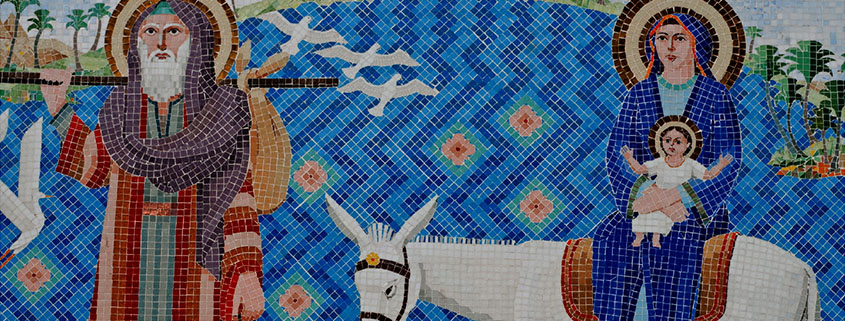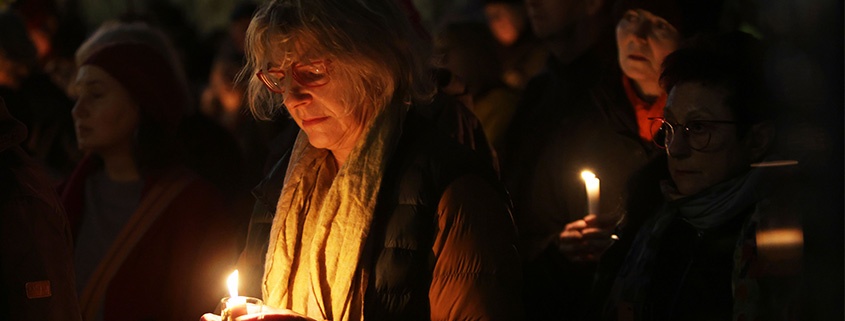This is the text of the Presidential Address given by Bishop Steven to Oxford Diocesan Synod on Saturday 18 November 2023.
I am going to begin with a familiar verse from Matthew’s gospel.
Then Joseph got up, took the child and his mother by night and went to Egypt and remained there until the death of Herod. This was to fulfil what had been spoken by the Lord through the prophet, “Out of Egypt have I called my son” (Matthew 2.14)
I’ve selected the image above for my official Christmas card this year. It’s a photograph of a mosaic at the entrance to what is called the Hanging Church in the heart of old Cairo, the most famous and one of the oldest Coptic Christian churches in Egypt. It’s called the Hanging Church because it’s built on top of two much older pillars which were part of a Roman fortress. Parts of the Church date from the third or fourth century, which makes it one of the oldest purpose-built church buildings in the world and the majority of the Church from the 7th century. There is a cave underneath the Church reputed to be where the Joseph and Mary and the infant Jesus sheltered from those who were searching for them. This modern mosaic, made from pieces of coloured stone, shows the holy family on their journey from Bethlehem through southern Israel/Palestine. They would no doubt have taken the coast road through Gaza and across Sinai to what is now Cairo, fleeing for their lives before Herod’s massacre of the innocent. There is a rich Coptic tradition which charts their journey within Egypt to many different places and of course, in due time, back to Nazareth.
My wife and I visited the Hanging Church a few weeks ago on 25 October on our first visit to Egypt to visit our son and daughter in law and our granddaughter, who are living in Cairo this year and will have a permanent home there. Our visit came just a few weeks after the devastating Hamas attacks on Israel which resulted in the deaths of 1,400 Israeli’s, including children and the elderly, and the taking of over 200 hostages. And in the weeks that have followed we have also seen the deaths of more than 10,000 Palestinians in Gaza and elsewhere including again many children in the most dreadful conflict the Middle East has seen for a generation and which continues today.
Our hearts break, I wept again last night as we saw on BBC News a little girl, the same age as our granddaughter, who had lost both her legs in the bombing in Gaza. Those conflicts have affected communities in our own country – including across the Thames Valley. We have seen a rise in antisemitism, in Islamophobia and a raising of the potential for serious conflict and division.
It was very striking on 25 October to see the conflict from Egypt, rather than from Oxford. We were taken to visit many different sites: the pyramids; the mummies; the ancient mosques, churches and synagogues but this one image of Jesus and Joseph and Mary has stayed with me as I’ve reflected on this deepening tragedy.
The story of salvation is here, worked out in a particular time and place. The journey of this Joseph echoes the journey of another Joseph, thousands of years earlier, who was taken as a slave to Egypt, betrayed by his own brothers. The journey of this family down to Egypt and then back again echoes the formational journey of the people of Israel, their deliverance from their own slavery as the quotation from Hosea 11.1 makes clear: ‘Out of Egypt have I called my son. Matthew, this most Jewish of the gospel writers, shows us clearly that the mission of God in Christ is to all the nations and not simply to God’s chosen people’.
There is a profound vulnerability in this picture of the Holy Family which Matthew offers us. They have no security, no family support and few resources. Mary most probably is in her teens. She has recently given birth. They are travelling by dangerous roads to a foreign land to seek safety, to places where they have never been and where perhaps the language and customs are unfamiliar. Behind them is cruelty and slaughter. Ahead is uncertainty. They are confident in God’s provision. And they bring with them the hope of the entire world, Jesus.
So we wonder at this Holy Family but wonder more at the grace of God in the incarnation pictured here in this mosaic. Almighty God, maker of heaven and earth, Lord of the universe, takes flesh and dwells among us not in safety and security but on the road, in dirt and danger, unguarded and alone except for Mary and Joseph. And this is the way God’s salvation is offered to the whole world. This is the nature of God’s grace: free, undefended, weaving a silent path through the suffering of the earth, finding the paths of hope and peace in the midst of deep conflict, making present the rich patterns of love written into the fabric of the universe. Love divine, all loves excelling, joy of heaven to earth come down and treading the road through Gaza to Egypt.
The picture helps us to find a perspective on the present conflict: to weep and lament but not to be paralysed into inaction or inured to suffering. It is our call first and foremost to prayer. It is our call to give generously for the relief of distress. It is the call for the flow of aid to begin in Gaza and to expand and continue; for the protection of non combatants; for the release of the hostages; for the revitalisation of the peace process; for the rekindling of hope of a just and lasting two state settlement.
And the picture is a call also to reach out within our own communities to both friends and strangers. And I know that this is happening in different places across the diocese. I was in Christ the Cornerstone in Milton Keynes on 15 October, to pray a blessing on the new city. It was moving to share in the lighting of candles of peace at the end of the service by Jewish, Christian and Muslim representatives. The faith leaders across Oxfordshire have now met together with civic leaders on three occasions since the 7 October. On 5 November we held an Oxfordshire vigil for peace in Broad Street attended by 500 people, who stood in silence as we remembered and as we prayed and held hands across our communities lest conflict in distant places cause divisions here. This building of community needs to continue in all of our villages and towns and cities. This is a season to reach out and love the stranger, to build bonds of friendship, to welcome the refugees because our Lord from the beginning of his life knew suffering and distress and identified with those who had no home.
The picture and these verses from Scripture also give a framing context for our ongoing reflections in the life of our own diocese on every subject on our agenda but particularly our debates on human sexuality. There will be many who feel a range of difficult emotions following the General Synod debates this week. We will need to continue to be sensitive to one another and gentle with each other during the coming months; to listen well; to be with each other. We have allowed additional time for reflection on General Synod this morning and I will offer my own perspective and of course, be willing to answer questions. I’m very sorry we are not together in person for that conversation on this occasion. But we remember the Christ child is in the midst even in our most difficult and sensitive conversations.
God inspired Joseph the son of Jacob in dreams with wisdom to solve impossible problems and to save and lead his people: a new wisdom greater even than all the scribes of Egypt. And God inspired Joseph, husband of Mary, in dreams when he did not know where to turn in his responsibilities as a husband and a father to play his part in the story of salvation as we must play ours. God will continue to give wisdom to his whole church as we listen together to the Spirit. I used the image of a mosaic in my own speech to General Synod this week, with this picture in my mind. We are seeking to build a greater and deeper Christian inclusion one step at a time, laying as it were new mosaic, respectful of each other’s deeply held views and consciences. None of us yet see the whole picture. We are building of course with cracked pieces of pottery, our own imperfect selves and our incomplete visions of the whole to make something yet more beautiful, like the practitioners of the Japanese art form kintsugi: the mending of cracked pots with seams of lacquer and gold. My prayer is that in due course, as painful though the process can be, we will yet see the face of Christ in this mosaic we are building: a face of gentle contemplation, of deep compassion, of world changing courage.
Which brings me to the final part of this address. The world needs to know and hear about this Christ child, who lives among us and travels into danger and exile for the sake of the whole world. This is the child who grows to show to all of us the way of love; who summarises the whole law of God into two commandments: you shall love the Lord your God with all your heart and soul and mind and strength and you shall love your neighbour as yourself.
Events in the world and events in the church reveal to us all that the world urgently needs to understand this way of love. I want therefore to invite all members of this Synod and all churches across the diocese to prepare well for Come and See in Lent next year. We will be focussing on this way of love in Jesus summary of the law and in the commandments. The diocese will be sending out invitations to sign up for Come and See and to access materials in the next few days. We want to offer a big warm open invitation to the communities of our diocese to come and meet this Jesus, to Come and See, to walk with us through Lent and to explore baptism and confirmation and to get to know this Jesus for themselves.
Then Joseph got up, took the child and his mother by night and went to Egypt and remained there until the death of Herod. This was to fulfil what had been spoken by the Lord through the prophet, “Out of Egypt have I called my son” (Matthew 2.14)
May we all do our best to follow in the way of Christ, in gentleness and love, to be a more Christ-like Church in this time of great peril for our world, and to make Christ known in our lives and through our words.
Amen.


